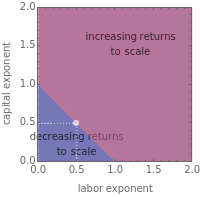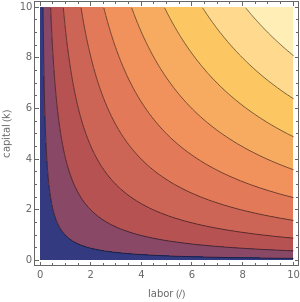Cobb-Douglas Production Functions
Cobb-Douglas Production Functions
Cobb-Douglas functions are frequently used in economics to show the relationship between input factors and the level of production. This family of functions takes on the form , where ℓ is one factor of production (often labor) and is the second factor of production (often capital). The sum of the exponents determines the returns to scale on factor inputs. This Demonstration visualizes Cobb-Douglas functions by letting the user select the input exponents and as well as a scaling factor . You can also select whether the resulting production function is to be displayed as a contour plot or as a three-dimensional plot.
a
α
ℓ
β
k
k
α+β
α
β
a
Details
Details
When , the Cobb-Douglas function is homogeneous, meaning that a doubling of both of the two inputs (at the same time) results in a doubling of the output. and are also the respective partial "output elasticities" of the production function, meaning that they measure the percent increase in production resulting from a percent increase in the particular input factor.
α+β=1
α
β
External Links
External Links
Permanent Citation
Permanent Citation
Seth J. Chandler
"Cobb-Douglas Production Functions"
http://demonstrations.wolfram.com/CobbDouglasProductionFunctions/
Wolfram Demonstrations Project
Published: September 28, 2007

